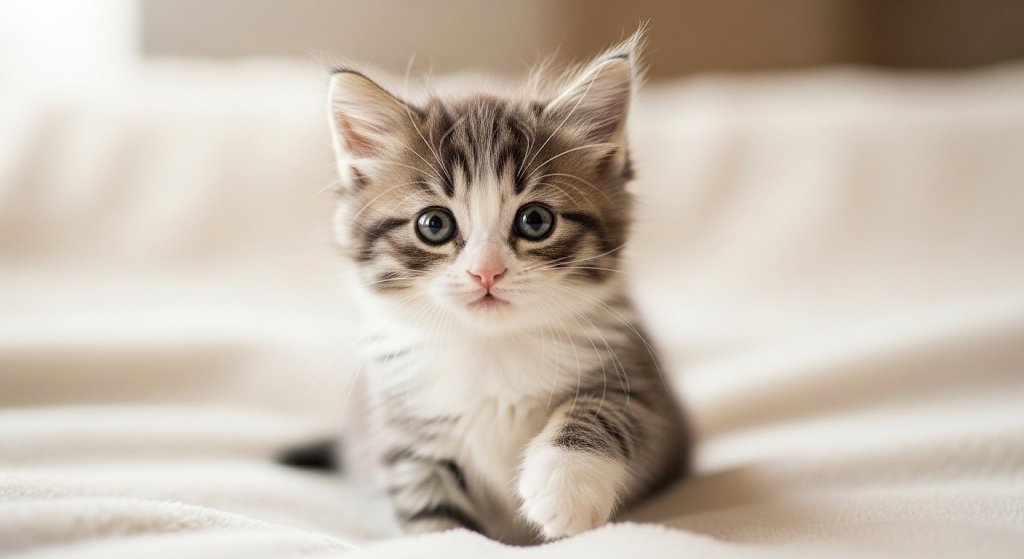
Learn what to feed your kitten, how long to use kitten food, and when to switch to adult cat food for healthy growth.
Why Nutrition Matters in the First Year
Kittens grow at an incredible pace. In just a few months, they go from tiny, fragile creatures to curious young cats. Proper nutrition provides the energy, protein, and minerals they need for bone development, immune system strength, and brain growth.
Failing to feed your kitten the right food can lead to stunted growth, weak immunity, or long-term health problems.
What Should Kittens Eat?
Kitten-Specific Food
Always start with food formulated specifically for kittens. Unlike adult cat food, kitten food contains:
- Higher protein (essential for muscle development)
- More fat (provides energy for growth and play)
- Key nutrients like DHA (for brain and vision development)
Look for packaging labeled “Complete and Balanced for Growth” by reputable pet food associations such as AAFCO.
Wet vs. Dry Food
- Wet food is easier to chew, provides hydration, and is usually more palatable.
- Dry food supports dental health and is convenient to store.
Most veterinarians recommend offering a mix of both for balance.
Real-World Tip
When I raised my first kitten, she refused dry kibble at first. I started by mixing a small amount of kibble into her wet food. Within two weeks, she happily ate both. This gradual method prevents picky eating habits later.
Kitten Food: How Long to Feed It?
A common question new cat owners ask is: “Kitten food—how long to feed?”
The answer: until about 12 months old.
Some larger breeds, such as Maine Coons, may benefit from kitten food for up to 15–18 months because they grow more slowly.
If you’re unsure, consult your veterinarian to adjust based on your kitten’s body condition and growth rate.
Switching From Kitten Food to Cat Food
Transitioning too early can deprive your kitten of essential nutrients. Transitioning too late may risk weight gain due to higher calorie density in kitten food.
Best practice for switching from kitten food to cat food:
- Start around your kitten’s first birthday.
- Gradually mix in 25% adult food with 75% kitten food.
- Over 7–10 days, increase the ratio of adult food.
- Monitor stool consistency and appetite—slow down if digestive upset occurs.
This step-by-step process ensures a smooth change without stressing your kitten’s digestive system.
Common Feeding Mistakes to Avoid
- Free-feeding dry food only – leads to overeating and obesity.
- Giving human food – onions, garlic, chocolate, and many other foods are toxic to cats.
- Skipping wet food entirely – hydration is critical for kidney health.
Quick Reference Table
| Kitten Age | Feeding Frequency | Food Type | Notes |
|---|---|---|---|
| 0–4 weeks | Every 2–3 hours | Kitten milk replacer | No cow’s milk |
| 4–8 weeks | 4–5 meals/day | Wet kitten food + softened kibble | Start weaning |
| 2–6 months | 3–4 meals/day | Kitten wet + dry mix | Rapid growth stage |
| 6–12 months | 2–3 meals/day | Kitten food | Prepare for transition |
| 12+ months | 2 meals/day | Adult cat food | Transition complete |
Additional Resources
- [Nutrition and Weight: Kittens]: Healthy Feeding Guidelines for Growing Kittens.
- [Internal Link 2]: Tips on indoor cat care, including diet, play, and environment.
- [Pet nutrition matters]: American Veterinary Medical Association – Feline Nutrition Guidelines.
Final Thoughts
Feeding your kitten isn’t just about filling a bowl—it’s about laying the foundation for a healthy, happy life. By choosing the right kitten food, sticking to an age-appropriate feeding schedule, and knowing when to switch to adult food, you can give your furry companion the best start possible.
Remember: every kitten is unique. Stay observant, make adjustments as needed, and work closely with your veterinarian to keep your kitten thriving.

Awesome 😍❤️✨